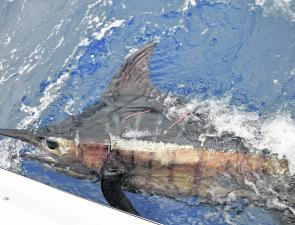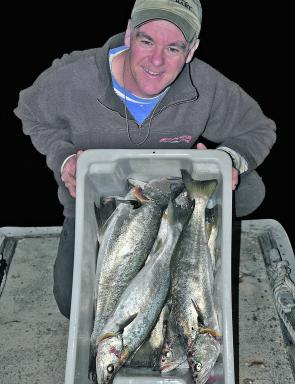Coffs Harbour’s offshore fishing is rarely dull. With an amazing year-round blend of tropical and cooler water species, coupled with periodic visitors streaming down from the north in summer, you never know what will jump on your line next.
The game fishing is legendary, with all three marlin species, sailfish, swordfish, tuna, kingfish, mackerel, wahoo, and any number of sharks present — either year-round or seasonally. There are more then eight sets of canyons along the 100 fathom line off Coffs, spread over a 60nm area, and all can produce on any given day. The trick is working out where to be at the right time. If you’re unsure, the 100 fathom line is as good as any a place to start, but the inshore reefs also hold plenty of bait and attendant pelagics.
Black marlin, from barely hatched 15kg fish to serious models over 120kg are on the cards in summer, and this inshore bite is what a lot of people sweat on every year. The quality is dictated by a healthy recruitment in Far North Queensland waters the previous spring. Some years the blacks don’t show here, yet they magically appear at Port Stephens, and heavy rain can really put the kybosh on the bite. This has occurred with unerring regularity in recent years. Just when all the planets align, the heavens open up…
Blue marlin are the big drawcard in the spring and summer months though, and are the most sought-after billfish species. Ranging in size from 90-180kg, with the occasional larger model, the most successful way to catch them is to troll a spread of three or four lures 20-36cm in length. The majority of blues are catchable on 24kg tackle, although 37kg ensures a faster catch, a healthier release, and no lost lures.
Acrobatic green and gold mahi mahi start to appear in spring, with some absolute honkers riding the first warm currents south. Most are bycatch on marlin lures, but spinning, jigging and live baiting around the FAD, wave recorder buoy and various fish trap floats will winkle out the better specimens. A cube trail with diced pillies can be used to draw them away, and a whole pillie on a light trace is rarely refused. Out wider, find a rogue trap float, a piece of timber or other debris floating about in warm, blue water and you’re in for a fun time.
The summer/autumn run of spotted and narrow-barred Spanish mackerel (known locally as ‘bar-ees’), is big news on the mid north coast, with hundreds of anglers suddenly contracting mackerel fever once reports start trickling in. The quality of the mackerel season is largely dependent on plenty of bait and clean water (it doesn’t necessarily have to be blue). Head-hooked live slimy mackerel (and to a lesser extent yellowtail) rigged on light single-strand wire and a stinger hook in the tail region are the first choice baits. However, when the mackerel are really on it can be extremely difficult to catch live bait. Then it’s time to try dead baits like garfish and – the big bar-ee specialty – chin-weighted whole dead bonito or frigate mackerel.
Seriola species such as yellowtail kings, samsonfish and to a lesser extent amberjack, lurk on high peaks inshore and on the deep reefs. The top end of South Solitary is kingie heaven when the current is pumping from the north, and they’ll happily eat jigs and live baits. An early start is usually best, being in position by sunrise. While of a different family, cobia are apt to turn up wherever the bait is thickest and grab livies being drifted and trolled for mackerel and marlin. The Wide Bait Ground is the go-to spot when they’re on.
The game fishing does go relatively quiet over winter, and those sou’westers, while fairly benign inshore, can really pipe up over the shelf. Striped marlin are on the cards inside the shelf line if the baitfish (sauries, pilchards and slimy mackerel) aggregate there, and yellowfin tuna well wide. Very few people drift and cube for tuna these days but it has to be worth a shot if conditions are suitable.
Winter is snapper time though, with big knobbies and plenty of smaller fish moving inshore to spawn. Anchoring and berleying with fish scraps, prawn shells and then fishing lightly-weighted pilchards down the trail is the highly successful, time-honoured approach. However, soft plastics and Lucanus jigs are a more active alternative — hunting the fish down rather than waiting for them to come to you.
Rushing out at the crack of dawn can be a mistake though, as the sou’westers usually pump pretty hard until 9am. If you anchor up to allow for the wind, the boat will simply swing off the mark when the breeze abates. Besides which, any earlier than this and it’s too bloody cold!
Around the full and to a lesser extent the dark of the moon, the teraglin come out to play. Loitering over peaks in 15 to 35 fathoms until after dark can really pay off with these sweet-eating fish. The bite is fast and furious, double-headers commonplace, and it is sometimes hard to stop at the five per person bag limit. Trag can also be caught in deeper water throughout the day. Sometimes it’s hard to avoid them, which is a pity as they don’t release well.
Other table species of note are pearl perch and tuskfish, both of which can be taken at anchor or on the drift with paternoster rigs using flesh baits like salted tuna, fresh slimy mackerel strips and pilchards. Pearl perch and tuskfish are two of the best eating fish in NSW waters, so you should promptly brain-spike them, bleed them and get them into a salty ice slurry. This is good practice for any table fish really.
Outside 60 fathoms and inside the continental shelf, bar cod are attracting increased attention these days. Hardly a great sporting fish, there’s still plenty of exercise to be had winding them up out of these depths. The lazier anglers among us use electric reels, which also opens up some deep dropping options for blueye, hapuka and bass groper in the various canyon features if the current isn’t flowing too hard. Actually, a few deepwater drops can help enliven an otherwise marlin-less day.
The poor old sand flathead, which is uber trendy in fish shops and restaurants these days, flies under the radar of most locals. That’s understandable though when there are so many other high profile sporting and table fish around. The flatties do move about, and inside the Patches is a known spot where double headers of 60cm fish are reasonably commonplace. Obviously these fish won’t show on a sounder, but any scattered bait sitting just above the bottom usually has a carpet of tasty frogs camped underneath.
If the hooks and sinker mysteriously go AWOL, move away quick smart; the dreaded Chinaman leatherjackets also mill about over the sand at times. Tasty enough to eat, they can chew through a mountain of terminal gear in the winter months, but are at their destructive worst outside 30 fathoms.
Unfortunately, the Coffs ramp is an absolute shocker so watch the surge, even on seemingly calm days. The alternative to launching and retrieving each day is to grab a pen at the marina, but proposed parking changes means there are likely to be very few all-day spots available, and parking times will be enforced. Hardly a sensible, enlightened move for a tourist town, is it?
Finally, bear in mind that north of the harbour is marine park country with a lot of no-fishing zones, so obtain the necessary map (or download the smartphone app) before hitting the water.
Reads: 7439
Colourful striped marlin can turn up at any time, but generally prefer the cooler water of autumn, winter and spring.

Big reds like this 88cm beaut are a winter staple at Coffs, and can be caught anywhere from just off the many headlands out to 50 fathoms.

Big mahi mahi help while away the time between marlin strikes.

The legendary pearl perch — definitely not a neighbour’s fish!

Like everywhere in NSW these days, yellowfin tuna can be extremely hit and miss, but where there’s one, a whole school is usually close behind.

Now that’s a tasty box of tuskies, arguably the best chewing fish in NSW waters.

Chunky blue marlin are the Coffs Harbour billfish angler’s major prize, and a lot of hours and sea miles are expended on each hook-up.

Around the full moon is traditionally teraglin time, but on some days they can be hard to avoid when drifting the deeper reefs.

Baby black marlin traditionally lob around Christmas and stay until April, or the first flooding deluge of summer rain.




